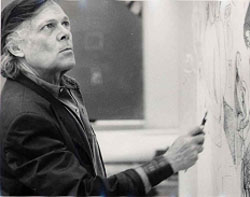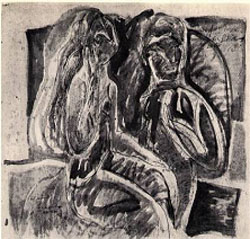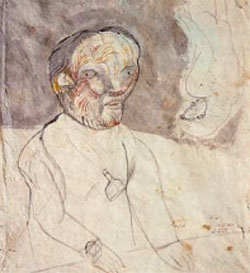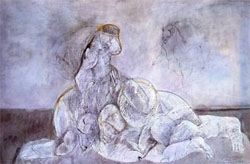 JOSE
LUIS CUEVAS: Evolution of an Artist. JOSE
LUIS CUEVAS: Evolution of an Artist.
Born
in 1934, in a paper factory in Triumph Alley, Mexico City, Jose Luis
Cuevas claims that
The ready supply of
something to draw on, an endless stream of bizarre characters outside his
window, and his own ill health …drove him to art… My first
recollection is of paper trimmings... Scattered over the floor like fallen
streamers and confetti from the paper punches, it was always a carnival at
my house… (Newton,
Edward. "Portrait of Mexican Master Painter". The Los Angeles
Times. April 27, 1989)
 At
an early age of ten, Cuevas spent a year in
bed with a heart ailment. During
this time, he developed a love of European literature and soon was
creating drawings that emerged out of what he read and saw in his feverish
hallucinations. By the time
Cuevas was 19, he held his first exhibition at the Prisse Gallery in
Mexico City. At this time, he was also holding seminars on the early
history of film and the influence of
film on promising artists of the time.
He was still passionately involved in his love for literature and
gave lectures on Dostoevsky, Dickens, and Roman Rolland. At
an early age of ten, Cuevas spent a year in
bed with a heart ailment. During
this time, he developed a love of European literature and soon was
creating drawings that emerged out of what he read and saw in his feverish
hallucinations. By the time
Cuevas was 19, he held his first exhibition at the Prisse Gallery in
Mexico City. At this time, he was also holding seminars on the early
history of film and the influence of
film on promising artists of the time.
He was still passionately involved in his love for literature and
gave lectures on Dostoevsky, Dickens, and Roman Rolland.
When
he was 23, he had his first one-man exhibition in the Prisse gallery.
His drawings involved portraits of poor children and prostitutes.
The following year, he exhibited in the Pan American Union in Washington,
D.C., which led to an interview in Time magazine.
In this article he voiced his dissent against exhibitions which
featured solely the work of Mexican artists.
In the same year, Cuevas began his campaign against the Mexican
muralists and wrote articles for cultural magazines.
 He
published his own manifesto, The
Cactus Curtain: An Open Letter on Conformity in Mexican Art. He
published his own manifesto, The
Cactus Curtain: An Open Letter on Conformity in Mexican Art.
In
1957, he illustrated the book The
Worlds of Kafka and Cuevas, and did a series of drawings for Life.
This prompted his first one-man show in New York at the Aerille
Gallery. Still continuing to
lecture against the native style of art, Cuevas stirred up rage in the
Mexican art world. In Lima,
he was challenged to a pistol duel.
Cheating death once again, he survived a major plane crash even
though his name was listed among the dead.
In 1962, he illustrated the book
Recollections of Childhood, which
also provided autobiographical text about him.
In
this world drawn from dream and memory, Jose Luis Cuevas, a persona of his
own imagination, serves as a guide and a witness to the noxious tragedy of
the human condition.
-Benjamin Walter
He
received the Prize for Excellence in Art and Design in the 29th
Annual Exhibition of he Art Directors' Club of Philadelphia (1964).
He continued his lectures on why his art caused so much
controversy. During one of
the seminars a clash erupted between his detractors and one of his
admirers.
Again
angering the public in 1966, Jose Luis Cuevas's exhibition in Mexico City
causes a violent public reaction, with written insults and threats. He
later responds through the press and television. In 1967, his
autobiography Cuevas por Cuevas was
published and was among the finalists that were considered for the
literary prize Xavier Villarrutia In
1968, he won the First International Prize for Engraving in the Triennial
1 of New Delhi, India.
Cuevas
continued to exhibit internationally and returned to Mexico in 1970, where
he was an independent candidate for the Mexican Chamber of Deputies
(representing Mexico City). He emphasized the necessity of creating a political party for
the young and intellectuals. In
1971, he became a member of the jury for the Central American Biennial in
San Jose, Costa Rica. An
artist infuriated by the decision of the jury, tried to assault Cuevas.
In
succeeding years, there was constant demand for his work in Paris, Peru,
Barcelona, Lima, Florida, London, San Francisco, Switzerland, Poland,
Sweden, Washington, Canada, Germany, and Romania.
He held ten simultaneous exhibitions in Mexico City.
 What
the Artist says about his work What
the Artist says about his work
Strongly
associated with the return of easel painting that marks contemporary
Mexican art the movement that Jose Luis Cuevas led against the School of
Mexico and muralists was rooted in a strong nationalistic ethic, hope for
a more elevated art community.
What
I want in my country's art are
broad highways leading out to the rest of the world, rather than the
narrow trails connecting one adobe village to next. (Author's
Last name, first name. Orozco's Heir: Jose Luis Cuevas The Insiders
PartTwo-The Rediscovery of Man: chapter 16-pgs 100-104. City of
Publication: Publishing Company, Publication date.)
When
speaking of his native-land, Cuevas still remains very loyal to
Mexico:
We
all live I the middle of an earthquake,…I'd say that in each Mexican
artist, there is the heart and mind of a revolutionary. We all carry
Pancho Villa around inside. ((Newton,
Edward. "Portrait of Mexican Master Painter". The Los Angeles
Times. April 27, 1989)
While
at PCC, a student asked Cuevas what he thought of Chicano art, Cuevas
replied;
Something
extraordinary is happening with the Chicanos,…they've created nostalgic
art that refers back to something expressed by their parents or their
grandparents. So powerful is this nostalgia with its references to Pancho
Villa and the Virgin of Guadalupe that it is sending tendrils across the
border toward it's source….we have these artists in Mexico now who are
returning to nationalism…they have a tremendous influence from Chicanos
working in the U.S.
When
asked why he singled out butchers, and whether his caricatures of the
clergy implied a rejection of God, Cuevas answered:
The
butcher is only a symbol of destructiveness;
being in this guise closer to the beast in man, he could be said to
represent what is sadistic and what is brutal in us.
I condemn the clergy forbidding egotistical or hypocritical.
But because man exists godlessly, it does not follow that I have
lost faith in God; only in
some of his self-styled servants.
Recopilado por Gabriel Gross
|

 JOSE
LUIS CUEVAS: Evolution of an Artist.
JOSE
LUIS CUEVAS: Evolution of an Artist. At
an early age of ten, Cuevas spent a year in
At
an early age of ten, Cuevas spent a year in He
published his own manifesto, The
Cactus Curtain: An Open Letter on Conformity in Mexican Art.
He
published his own manifesto, The
Cactus Curtain: An Open Letter on Conformity in Mexican Art.  What
the Artist says about his work
What
the Artist says about his work